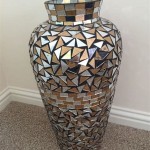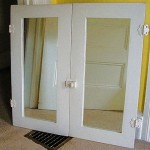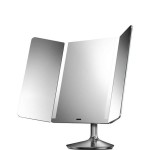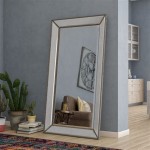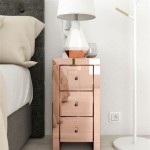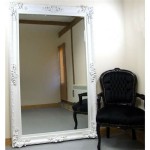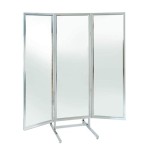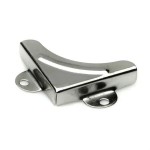Mirrors for Above Dressers: A Guide to Style, Functionality, and Selection
A mirror above a dresser serves both a practical and aesthetic purpose in a bedroom. It provides a convenient spot for checking one's appearance while also contributing significantly to the room's overall design. Choosing the right mirror can enhance the dresser's style, make the room feel larger, and even influence the lighting. This article explores the key considerations for selecting and placing a mirror above a dresser.
Mirror Styles and Frames
Mirrors come in a wide variety of styles and frame designs, each contributing a different aesthetic to the space. Simple, frameless mirrors offer a sleek and modern look, blending seamlessly with minimalist or contemporary decor. For a more traditional or ornate feel, framed mirrors offer a range of options, from elaborately carved wood to sleek metallic finishes. The frame material and design should complement the dresser's style and the overall bedroom aesthetic. For example, a rustic wooden frame pairs well with a similar dresser and farmhouse-style decor, while a thin metal frame suits a modern or mid-century modern setting.
The shape of the mirror also plays a critical role in its visual impact. Rectangular and square mirrors are versatile choices, providing a classic and balanced look above most dressers. Round or oval mirrors offer a softer, more organic feel and can break up the linear lines of a rectangular dresser. More unique shapes, such as arched or geometric mirrors, can add a bold statement and become a focal point of the room. Ultimately, the chosen shape should harmonize with the dresser's proportions and the overall design of the room.
Size and Proportion
Selecting the correct mirror size is crucial for achieving a balanced and visually appealing arrangement. The mirror should be proportionate to the width of the dresser, ideally being slightly narrower than the dresser's top surface. A mirror that is too wide can overwhelm the dresser, while one that is too narrow can look out of place and insignificant. A general guideline is for the mirror to be between two-thirds and three-quarters of the dresser's width.
The height of the mirror also contributes to the overall aesthetic. Taller mirrors can create an illusion of height in the room, while shorter, wider mirrors can emphasize width. The height should also be considered in relation to the ceiling height and the distance between the dresser and the ceiling. Leaving sufficient space between the top of the mirror and the ceiling prevents a cramped appearance and allows the eye to travel comfortably around the room. Consideration should also be given to the user's height, ensuring the mirror provides adequate viewing space for its intended purpose.
Placement and Mounting
Proper placement and secure mounting are essential for both safety and aesthetics. The mirror should be centered above the dresser, ensuring equal spacing on both sides. The bottom edge of the mirror should be a comfortable distance above the dresser top, allowing enough space for decorative items or practical necessities. A typical distance is between 4 to 8 inches, but this can vary depending on the dresser's height and the overall room layout.
Securely mounting the mirror to the wall is critical to prevent accidents. Different mounting hardware is suitable for different wall types and mirror weights. Heavy mirrors require robust anchors and screws specifically designed for their weight and the wall material. Consulting the mirror manufacturer’s instructions and utilizing appropriate wall anchors is crucial for ensuring stability and preventing damage to both the wall and the mirror. Prior to drilling, ensure the wall behind the dresser is free of electrical wiring or plumbing.
The mirror's reflection also plays a role in its placement. Carefully consider what the mirror will reflect. Ideally, it should reflect a pleasant view or a well-lit area, rather than a cluttered corner or a blank wall. Strategic placement can maximize natural light or enhance the visibility of other decorative elements in the room.
Integrating with Room Decor
The mirror above the dresser should seamlessly integrate with the overall room decor. Consider the room's existing color palette, textures, and styles when selecting a mirror. The mirror can either blend harmoniously with the surroundings or serve as a contrasting accent piece, adding a touch of visual interest. For example, a metallic framed mirror can introduce a touch of glamor to a neutral-toned room, while a natural wood frame can complement a bohemian or rustic aesthetic.
The mirror can also be used to enhance the room's lighting. Placing the mirror opposite a window can reflect natural light, brightening the space and creating a sense of airiness. Alternatively, placing the mirror near a light fixture can amplify the light source and create a more dramatic effect.

Mirror Above Dresser Design Ideas

15 Best Round Mirrors Thetarnishedjewelblog Home Bedroom Design

Mirror Above Dresser Design Ideas

Mirror Above Dresser Design Ideas

Mirror Above Dresser Modern Bedroom Decor Design

How High To Hang Mirror Over Dresser Ideal Height

Layne Round Wall Mirror Pottery Barn

Favorite Wall Mirrors Of Every Shape Room For Tuesday Dresser Top Decor Styling

Bedroom Dresser Decor

28 Spectacular Bedroom Mirror Ideas To Complete Your Room

